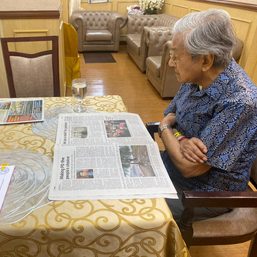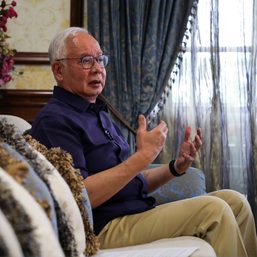SUMMARY
This is AI generated summarization, which may have errors. For context, always refer to the full article.

MANILA, Philippines – The Philippines is one of the countries in Southeast Asia that uses halamang-gamot, or medicinal plants, as alternative remedies for common diseases.
The government has likewise realized its importance. In 1997, Republic Act 8423, or the Traditional and Alternative Medicine Act (TAMA) was enacted into law, leading to the creation of the Philippine Institute of Traditional and Alternative Healthcare (PITAHC).
PITAHC – an attached agency of the Department of Health (DOH) – was established for the research and development of traditional and alternative healthcare in the country.
Slow progress, untapped funds
Since the establishment of PITAHC in 1997, the DOH has endorsed only 10 scientifically-validated herbal plants.
Rappler talked to former health secretary and advocate of traditional medicine Dr Jaime Galvez-Tan, who said that the gaps between PITAHC and DOH hold back the advancement of the traditional and alternative system.
Even under Dr Juan Flavier, former senator, health secretary, and sponsor of TAMA, Tan recalled that “for 60 years, DOH has been underfunded severely.” Despite this, they used the department’s budget to push for the recognition of 10 herbal plants.
For PITAHC, he said, the budget should no longer be a problem since the money coming from sin taxes can be tapped for funding. He added that the seeming lack of strong political will on the part of management is one reason why the agency has achieved less throughout the years. (READ: Senate approves higher taxes on cigarettes, tobacco products)
“It boils down to the leadership of PITAHC. Alam ba n’ya ‘yung potential para magkapera? (Does he know the potential to have money?) Hanggang ngayon, umaasa sila sa (Until now they’re dependent on the) mercy of the DOH secretary to allocate them money. Parang kapag tiningnan mo (When you look at it), the leadership of PITAHC is not driven…to fulfill [its] whole mission and be known,” he said.
Tan said that when the agency was initiated, they envisioned it to be widely known like the Philippine Health Insurance Corporation (Philhealth). But succeeding health secretaries did not seem to be interested in alternative medicine.
Below are the 10 herbal plants recommended for medicinal use by the DOH’s Traditional Medicine Program. Other listings of medicinal plants for further clinical test and trial can be seen here.
Tan also said that the DOH does not even acknowledge other herbal medicines that have been studied by Filipino scientists, making the list of validated medicinal plants too short. He only hopes that PITAHC and the DOH could have a more synergistic relationship to better integrate traditional and alternative medicine into the country’s healthcare system.
Get vaccinated
Rappler talked to another physician, Jondi Flavier, son of the late senator and former health secretary, about the limitations of using herbal plants not included in the DOH list.
He said, “Ang daming traditional o culturally recognized as herbal medicine…pero ‘yung napatunayan napakakaunti (Many are traditional or culturally recognized as herbal medicine, but only few have been proven to be effective).“
Tawa-tawa, for instance, is acceptable for dengue. According to Flavier, researches have shown that this plant can improve the platelet counts of a dengue patient. However, he warned that tawa-tawa can only be an alternative remedy for dengue, but not a cure for it.
Tan, however, said, “That can be true. But ang daming halaman na proven effective, ayaw lang kilalanin.” (But there are a lot of plants that have proven to be effective, but have not been recognized.)
Many Filipinos have turned to herbal plants to nurse sickness, especially this year when the DOH saw outbreaks of vaccine-preventable diseases such as measles and polio.
When asked if herbal plants can cover these diseases, Flavier said no. Instead, he raised the importance of vaccination. (READ: FAST FACTS: DOH’s Expanded Program on Immunization)
“Para sa mga ‘yan, may napatunayan na epektibong bakuna…Mahalaga ang bakuna bago magkasakit,” he said. (For those, vaccines have been proven to be effective. It is important to be vaccinated to avoid getting sick.)
He added that herbal plants are useful only for prevention, but not for curing. Besides, not all are safe, nutritional, and efficient. Some might even be harmful if they contain toxic chemicals.
In the lens of traditional medicine, Tan gave general advice on when a plant can be used as medicine. He said that if the leaf smells sweet or “mahalimuyak” it is safe to use. But if it tastes bitter, that might be toxic – unless there’s a study affirming it’s safe like ampalaya or bitter gourd.
Fight false information
The DOH saw a low vaccination rate this year because the public lost trust and confidence in medically-proven vaccines due to the Dengvaxia controversy.
Flavier said that to fight disinformation, there must be health promotion and proper information dissemination.
“Labanan pa rin ang maling balita. O kung nag-aalangan ang tao, dapat may magpapaliwanag (Fight false news. Or if people are confused, someone should explain to them),” Flavier said. – Rappler.com
Add a comment
How does this make you feel?





There are no comments yet. Add your comment to start the conversation.